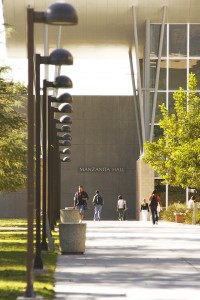Rethinking the News and How We Gather It: CSUN Journalism Program Gets a Redesign
CSUN’s Department of Journalism has transformed its curriculum to better prepare students for the rapidly evolving industries of journalism, public relations, television and beyond.

A shot of Manzanita Hall taken from the Sierra Quad walkway.
After celebrating its 60th anniversary in 2018, heads of the department and other university leaders set out to place greater emphasis on multimedia digital storytelling, news literacy and engaging with diverse communities.
In the current era of agenda-setting rhetoric and accusations of fake news, gone are the days of specialty journalism. Faster turn-around times, tighter deadlines, dwindling mediums such as daily newspapers, the emergence of new online publications and the 24-hour news cycle have all contributed to shifts in how news is created, delivered and consumed.
As society has changed and gone digital, why not journalism? Rather than separating and teaching journalism as components — radio, newspaper, television and magazine — schools should be willing to learn digital media from their students and involve it more in the curriculum. In recent years, experts in the field have advised schools to move to digital with a focus on multimedia storytelling rather than specialty areas. That is exactly what the department at CSUN is doing.
“The silos are gone,” said department Chair Linda Bowen. “Everything is really fluid across these things and we wanted to get with the program, so that our curriculum could show that.”
The department began to roll out the changes during the fall 2018 semester. And starting in late August with the 2019-20 academic year, incoming students (freshmen and transfer) will choose from three revamped tracks: general journalism, broadcast and public relations.
“We refreshed the program,” Bowen said. “We didn’t get rid of the things that we’re known for — like the broadcast program. We know [those] students get jobs right out of school. We didn’t want to go backward. We wanted to make sure that we were moving forward.”
Faculty and administration added 11 new courses to the program, and revamped 15 other courses to reflect the current state of journalism and prepare future journalists with the correct set of tools to succeed.
The journalism major at CSUN hadn’t seen massive curriculum changes since 2004. This year’s redesign tackled the drastic changes in the ways news media is produced, distributed and consumed. Faculty are encouraging more students to pursue an interdisciplinary field rather than the outdated “collateral field” that was like a mini-minor and was perceived by students as more restrictive.
“During my undergrad program, I didn’t see as much of a focus on multimedia journalism as I see now,” said mass communication graduate student Sarah Shabbar ’15 (Journalism). “I feel as if the program is becoming more visual, still with the emphasis on writing.”
One key factor driving CSUN’s change was a national shift, reflecting the industries’ seismic changes. Recently, the Accrediting Council on Education in Journalism and Mass Communications relaxed their national curriculum, according to Bowen, removing what administrators called the “80-65 Rule,” which demanded students complete 80 units outside of journalism, with a minimum of 65 units in liberal arts, sciences and the humanities, as well as 15 units in a “collateral field,” like history and geography.
This has opened up more possibilities for journalism students to take courses in fields outside the previous “acceptable list” and gain experience in various concepts.
“Say a student wanted to do a specialty in social justice,” said Bowen. “They could look around the university, see courses that don’t mimic journalism, maybe take classes in ethnic studies or anthropology and that would be an interdisciplinary field.”
Some of the new and exciting classes offered in the program are JOUR 325 – Multiplatform Storytelling and JOUR 365 – News Literacy. The former sharpens students’ multimedia production skill set by applying it across multiple platforms like social media. The latter encourages discussion by getting students involved in analyzing everyday news and information from a multitude of sources.
“News literacy is important because students can learn how to find credible sources and steer away from fake news,” said Bryanna Winner, assistant sports editor for CSUN student newspaper The Sundial. “New students should be excited for these classes, because they learn about different portions of journalism that other schools and programs may not offer.”
CSUN’s interdisciplinary minor in Spanish-language journalism remains the same under the new program. The journalism minor, however, has been modified to reflect the revamp. The department is in the planning stages of creating a minor in broadcast and public relations.

 experience
experience